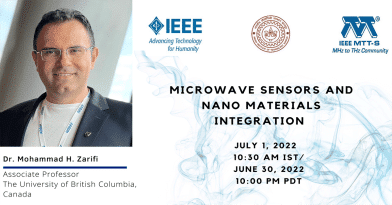
-
Friday, July 01, 2022 10:30 am - 11:30 am(New Delhi Time) Add to my calendar
Microwave Sensors and Nano Materials Integration
Dr. Mohammad H. Zarifi
The University of British Columbia, Canada
Abstract: Microwave sensors integrated with 1D and 2D materials are of great interest in various applications such as defense, health and safety, and environmental monitoring. They have received considerable attention due to their non-contact, real-time, portable, and CMOS-compatible sensing capabilities. Through electromagnetic field interactions, these sensors detect dielectric materials in their proximity, represented by changes in their electrical parameters such as resonant frequency, resonant amplitude, and quality factor. Microwave sensors, which are inherently insensitive to gas molecules, can be integrated with nanostructures allowing for rapid and real-time detection of hazardous gasses and vapors. Materials such as graphene oxide/polyaniline coated on the sensitive region of the resonator interacted with target hazardous gasses such as ammonia and demonstrated a remarkable sensitivity of 0.038 dB ppm−1 for concentrations as low as 1 ppm. MXene as novel material with promising conductivity and flexibility have been employed in designing antennas capable of sensing VOC while wirelessly transmitting the sensing data to a distanced receiver. The fabricated lightweight MXene antenna demonstrated wireless transmission capabilities and a potential to be implemented in 5G networks, featuring 57% of the thickness and 26.66% of the weight compared to similarly designed copper-based structures. This talk will focus on these emerging microwave/material technologies and will discuss also wide band-gap nanostructures such as TiO2 to enable light insensitive microwave resonators to detect low levels of ultraviolet radiation.
Speaker’s Bio: Mohammad H. Zarifi (P.Eng., IEEE Senior Member) received his Ph.D. from the University of Tabriz in Iran for his research in high-speed and low-power analog integrated circuit design, analog-to-digital converters for biomedical and communication applications. Following completion of his Ph.D., Dr. Zarifi undertook a post-doctoral fellowship at the University of Alberta investigating microwave planar resonator structures and Microelectro-Mechanical Systems (MEMS) for sensing applications. He is the 2015 recipient of the CMC-NRC first place award, on industrial collaboration, for the innovative microwave sensors. In 2017, Dr. Zarifi joined the School of Engineering at The University of British Columbia, where he is currently an Associate Professor. He has authored or coauthored over 150 technical conferences, letter, journal articles, and book chapters. Dr. Zarifi’s research interests include microwave sensors, antenna sensors, nanomaterials assisted microwave devices, high-frequency integrated circuits and systems, and wearable electronics. Dr. Zarifi is a member of IEEE MTT-S TC- 26 “RFID, Wireless Sensor and IoT” and a senior member of the IEEE Solid-State Circuits Society, and the IEEE Circuits and Systems Society, and serves as a reviewer for several journals and conferences.
This webinar is organized by IEEE MTT-S Student Branch Chapter, Indian Institute of Technology, Kanpur.